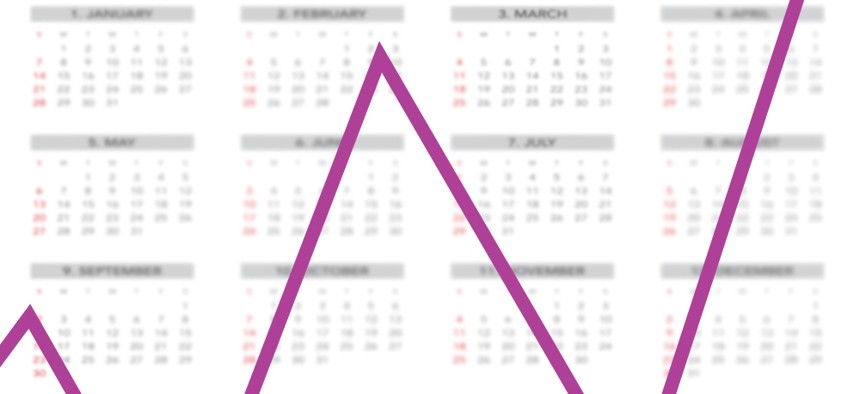How New York nonprofits can make the most of awareness months
Well-timed fundraising events can be one way to take advantage of the increased media attention awareness months bring.

Data analytics show whether awareness months correlate to when people are searching terms like hunger, foster care, mental health and other human services topics. Illustration by Zach Wiliams
Domestic Violence Awareness Month. Teen Dating Violence Awareness Month. Hot Dog Month?
New York nonprofits say they benefit from awareness months dedicated to their causes – but whether that translates into more dollars depends on the strategy.
Well-timed fundraising events can be one way to take advantage of the increased media attention awareness months bring, experts say.
Brian Pacheco, director of public relations for Safe Horizon, a New York nonprofit dedicated to ending family and community violence, helps run Safe Horizon’s national domestic violence campaign during Domestic Violence Awareness Month in October. The Put the Nail In It campaign is part fundraising, part awareness, he said. Participants are asked to vow to help end domestic violence by donating to Safe Horizon, painting their ring fingernail purple, and using #PutTheNailInIt on any and all social media platforms.
According to Pacheco, the best way to capitalize on an awareness month is to take advantage of the increase in media coverage. “The donations that we get during those months are because we’re proactively putting out focused messaging. There’s more news stories out there, more articles out there, there’s more noise about it,” said Pacheco.
In 2017 Safe Horizon received $80,000 when a board member offered to match donations made during a Child Abuse Awareness Month fundraising campaign.
“I would tell any nonprofit that they should be factoring awareness months into their planning. There's definitely a benefit.”
Ron Gold, founder and president of Marketing Works PR, a public relations firm that works with New York nonprofits, wants to see more organizations follow Safe Horizon’s example.
“It seems like the agencies are set in their ways as far as when they believe that the best time to do an event would be,” Gold said.
As a result, the true potential of awareness months can go unfulfilled.
“Whether it’s an epilepsy month or a mental health month, it brings out an opportunity for an agency to get some visibility, and that’s what they look for.” said Gold.
Awareness months can also be successful when they inspire others to fundraise for your cause.
The Epilepsy Foundation has celebrated November as Epilepsy Awareness Month since 1969. Congress eventually passed a resolution to officially recognize it in 2003.
“We’ve had high school students do fundraisers in November. People do things like that for us, so fundraising does increase,” said Irene Rodgers, director of community services for EPIC Long Island, a Long Island-based nonprofit that serves individuals with epilepsy.
EPIC Long Island kicks off its celebrations with a walk in October that helps build momentum. “We do a pretty healthy campaign on social media, we use a lot of hashtags,” said Rodgers.
It is surprisingly unclear how to create an awareness month or find out who’s keeping track of them. Some were established by government agencies, others by advocacy organizations. Some seem to have appeared out of nowhere.
After calls to federal, state and city offices, and relevant nonprofits, no official list or registry of “months” could be confirmed. The Library of Congress website has a list of 11 history or heritage months but it does not include cause-related awareness months. A quick look at wikipedia yields a list of at least 150 observances covering all twelve months. However, July is dominated by food observances. Hot dog, pickle, relish and pancake celebrations dominate the month.
In some instances it seems the only thing needed to claim a month is a critical mass of celebrants.
According to the National Resource Center on Domestic Violence, Domestic Violence Awareness Month was started by the National Coalition Against Domestic Violence in 1981 as a Day of Unity that worked to connect advocates across the nation and eventually generated enough interest to expand to an entire week. Eight years later, Congress passed a law designating October of that year as National Domestic Violence Awareness Month.
According to Mental Health America’s website, May became Mental Health Awareness Month in 1949. Since then they have used media and and local events to encourage millions of people to celebrate it.
But for some organizations, the existence of a month is a benefit in itself because it forces discussions that might not otherwise happen.
Federation of Organizations, a Long Island-based nonprofit that advocates for individuals with mental illness, sees Mental Health Awareness Month as an opportunity to break down stigmas surrounding the disease.
“We don’t experience it as some kind of peak in regards to fundraising, but the enhanced awareness is a public service,” said CEO Barbara Faron.
“It’s not a topic that’s on the tip of everyone’s tongue,” she added.
Editor's Note: This piece was updated to correct references to the location of EPIC Long Island and Federation of Organizations.